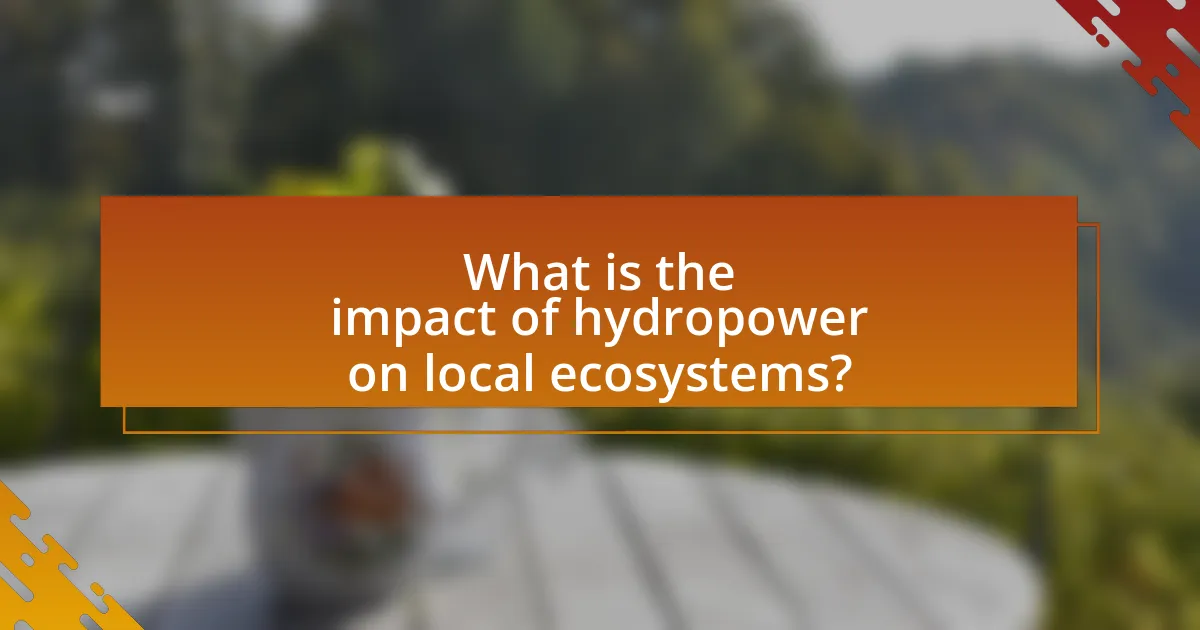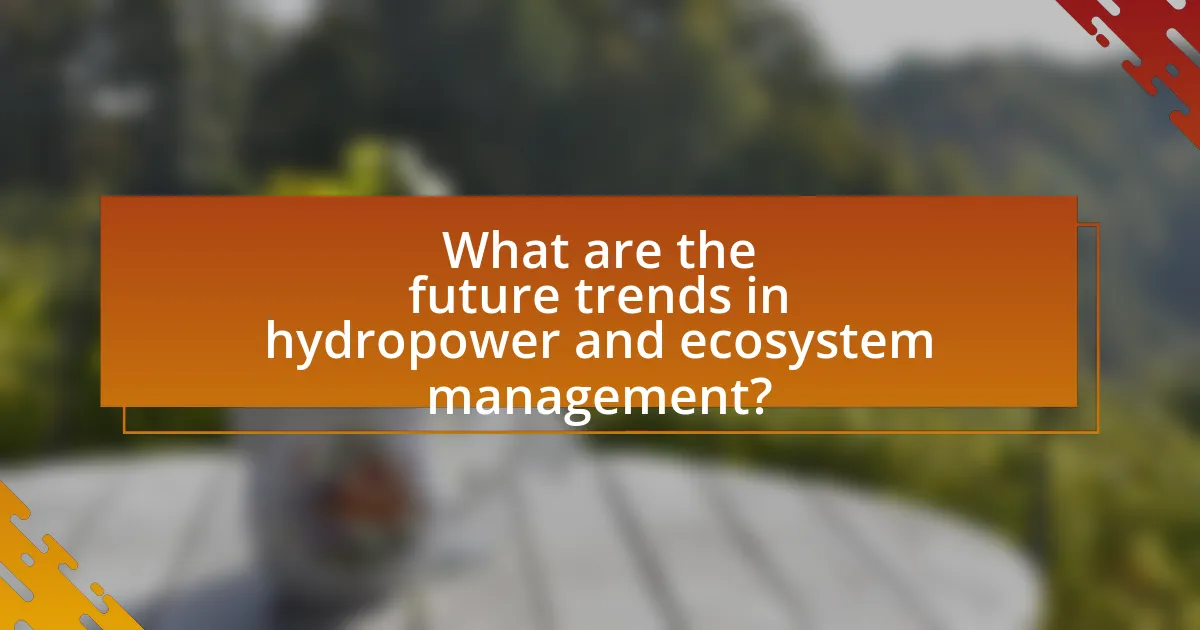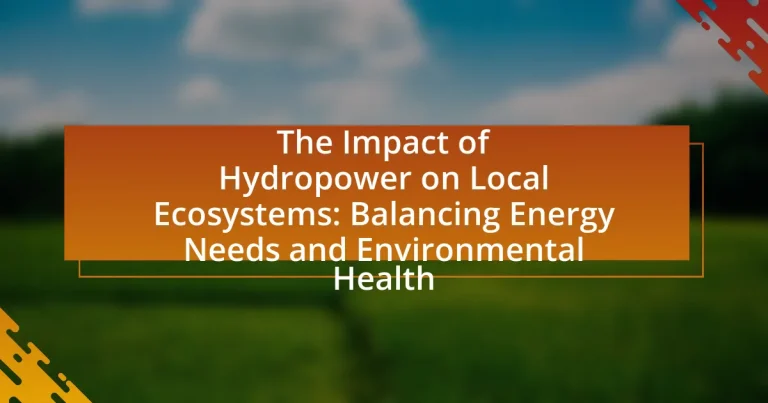The article examines the impact of hydropower on local ecosystems, highlighting the significant alterations to water flow, aquatic habitats, and species migration caused by dam construction. It discusses how hydropower generation affects aquatic life, particularly migratory fish species like salmon, and the environmental consequences of hydropower dams, including habitat loss and changes in water quality. The article emphasizes the importance of balancing energy needs with environmental health, outlining strategies such as fish passage systems and adaptive management to mitigate negative impacts. Additionally, it explores the role of community engagement and technological innovations in promoting sustainable hydropower practices.

What is the impact of hydropower on local ecosystems?
Hydropower significantly impacts local ecosystems by altering water flow, affecting aquatic habitats, and disrupting species migration. The construction of dams changes the natural flow of rivers, which can lead to habitat loss for fish and other wildlife. For instance, studies have shown that dams can block migratory routes for salmon, leading to population declines. Additionally, the alteration of water temperature and sediment transport can further disrupt local ecosystems. Research indicates that these changes can result in decreased biodiversity and altered community structures in aquatic environments.
How does hydropower generation affect aquatic life?
Hydropower generation significantly affects aquatic life by altering natural water flow, which can disrupt habitats and migration patterns. Dams and reservoirs created for hydropower can lead to changes in water temperature, sediment transport, and nutrient cycling, all of which are critical for the health of aquatic ecosystems. For instance, studies have shown that fish populations, particularly migratory species like salmon, can decline due to barriers created by dams that prevent access to spawning grounds. Additionally, the alteration of flow regimes can result in changes to the composition of aquatic communities, favoring some species over others and potentially leading to a loss of biodiversity.
What specific species are most affected by hydropower projects?
Fish species, particularly salmonids such as Chinook salmon and steelhead trout, are most affected by hydropower projects. These species rely on free-flowing rivers for migration and spawning, and hydropower dams disrupt their natural life cycles by blocking access to upstream habitats. Studies have shown that populations of these fish can decline significantly due to altered water flow, temperature changes, and increased predation in reservoir areas created by dams. For instance, the National Oceanic and Atmospheric Administration reported that salmon populations in the Columbia River Basin have been adversely impacted by hydropower operations, leading to a decrease in their numbers and genetic diversity.
How do changes in water flow impact fish populations?
Changes in water flow significantly impact fish populations by altering their habitats, spawning grounds, and food availability. For instance, increased water flow can lead to habitat destruction, while decreased flow can result in stagnant water conditions that are detrimental to fish health. Studies have shown that fluctuations in flow can disrupt the migration patterns of species such as salmon, which rely on specific flow conditions for successful spawning. Additionally, changes in flow can affect the distribution of aquatic plants and invertebrates, which are crucial food sources for fish. Research indicates that hydropower operations, which often modify natural water flow, can lead to declines in fish populations due to these habitat changes and altered ecological dynamics.
What are the environmental consequences of hydropower dams?
Hydropower dams have significant environmental consequences, primarily including habitat alteration, disruption of aquatic ecosystems, and changes in water quality. The construction of dams floods large areas, leading to the loss of terrestrial habitats and biodiversity. For instance, the creation of reservoirs can submerge forests and wetlands, which are crucial for various species. Additionally, hydropower dams impede fish migration, affecting species such as salmon that rely on upstream spawning. Research indicates that over 40% of the world’s rivers are fragmented by dams, which disrupts natural flow regimes and sediment transport, essential for maintaining healthy river ecosystems. Furthermore, the alteration of water temperature and chemistry in reservoirs can lead to harmful algal blooms, impacting water quality and aquatic life.
How do dams alter river ecosystems?
Dams alter river ecosystems by disrupting natural water flow, which affects sediment transport, water temperature, and aquatic habitats. The construction of a dam creates a reservoir that changes the river’s hydrology, leading to reduced water velocity and altered sediment deposition patterns. This can result in the loss of habitats for fish and other aquatic organisms, as well as changes in species composition. For instance, studies have shown that dams can lead to a decline in fish populations, particularly migratory species like salmon, which rely on free-flowing rivers for spawning. Additionally, the alteration of water temperature due to stratification in reservoirs can further impact aquatic life, as many species are sensitive to temperature changes.
What are the effects of sedimentation on local habitats?
Sedimentation negatively impacts local habitats by altering water quality, reducing light penetration, and smothering aquatic organisms. Increased sedimentation can lead to higher turbidity levels, which decreases photosynthesis in aquatic plants and disrupts food webs. Additionally, sediment can bury spawning grounds for fish and invertebrates, leading to declines in their populations. Studies have shown that excessive sedimentation can result in a loss of biodiversity, as species that rely on clear water and stable substrates are particularly affected. For instance, research indicates that in rivers impacted by sedimentation, fish populations can decline by up to 50% due to habitat degradation.
Why is balancing energy needs with environmental health important?
Balancing energy needs with environmental health is crucial to ensure sustainable development and the preservation of ecosystems. The demand for energy, particularly from sources like hydropower, can lead to significant ecological disruptions, such as habitat loss and altered water quality. For instance, a study by the World Commission on Dams found that large dam projects can displace local communities and disrupt aquatic ecosystems, affecting biodiversity. Therefore, achieving a balance allows for the generation of necessary energy while minimizing negative impacts on the environment, ultimately supporting both human and ecological well-being.
What are the long-term implications of ignoring ecosystem health?
Ignoring ecosystem health leads to biodiversity loss, which destabilizes ecosystems and diminishes their ability to provide essential services such as clean water, air purification, and climate regulation. Over time, this degradation can result in increased vulnerability to natural disasters, such as floods and droughts, as well as the collapse of fisheries and agricultural systems that rely on healthy ecosystems. For instance, the World Wildlife Fund reports that habitat destruction and pollution have contributed to a 68% decline in global wildlife populations since 1970, highlighting the urgent need for ecosystem preservation to maintain ecological balance and human well-being.
How can sustainable practices mitigate negative impacts?
Sustainable practices can mitigate negative impacts by promoting environmentally friendly methods that reduce ecological harm. For instance, implementing fish passage systems in hydropower projects allows aquatic species to migrate, thus maintaining biodiversity and ecosystem balance. Research indicates that such systems can increase fish populations by up to 50% in affected areas, demonstrating their effectiveness in preserving local ecosystems while still meeting energy demands. Additionally, utilizing renewable energy sources, such as solar or wind, minimizes reliance on hydropower, further reducing potential disruptions to water ecosystems.
What strategies can be employed to minimize hydropower’s ecological footprint?
To minimize hydropower’s ecological footprint, strategies such as implementing fish passage systems, optimizing reservoir operations, and utilizing run-of-river designs can be employed. Fish passage systems, like fish ladders or bypass channels, facilitate the migration of aquatic species, thereby maintaining biodiversity and ecosystem health. Optimizing reservoir operations involves adjusting water release schedules to mimic natural flow patterns, which can help sustain downstream habitats and aquatic life. Run-of-river designs, which generate energy without large reservoirs, significantly reduce land inundation and habitat disruption, preserving local ecosystems. These strategies collectively contribute to a more sustainable approach to hydropower, balancing energy production with environmental conservation.
How can hydropower projects be designed to protect local ecosystems?
Hydropower projects can be designed to protect local ecosystems by incorporating features such as fish passages, sediment management systems, and environmental flow releases. Fish passages, like ladders or bypass systems, allow aquatic species to migrate freely, which is crucial for maintaining biodiversity and population health. Sediment management systems prevent the accumulation of sediment in reservoirs, ensuring that downstream habitats remain intact and functional. Environmental flow releases mimic natural river conditions, supporting the ecological integrity of the river ecosystem by maintaining water quality and habitat availability. Studies have shown that these design elements significantly reduce the negative impacts of hydropower on local ecosystems, promoting a balance between energy production and environmental health.
What role do fish ladders and bypass systems play?
Fish ladders and bypass systems facilitate the migration of aquatic species, particularly fish, around barriers such as dams. These structures allow fish to navigate upstream and downstream, ensuring their access to spawning habitats and maintaining population sustainability. Research indicates that fish ladders can increase fish passage success rates by up to 90% in some cases, thereby supporting biodiversity and ecosystem health. By enabling the natural movement of species, these systems help mitigate the ecological impacts of hydropower installations on local ecosystems.
How can environmental assessments improve project outcomes?
Environmental assessments can improve project outcomes by identifying potential environmental impacts early in the project planning process. This proactive approach allows project developers to mitigate adverse effects on local ecosystems, ensuring compliance with environmental regulations and enhancing community acceptance. For instance, a study by the World Bank found that projects with thorough environmental assessments are 30% more likely to succeed in meeting their objectives, as they incorporate stakeholder feedback and ecological considerations into their design. By addressing these factors, environmental assessments lead to more sustainable and effective project implementations, ultimately benefiting both energy needs and environmental health.
What are the best practices for managing water resources in hydropower?
The best practices for managing water resources in hydropower include implementing integrated water resource management (IWRM), optimizing reservoir operations, and ensuring environmental flow requirements. IWRM promotes the coordinated development and management of water, land, and related resources to maximize economic and social welfare without compromising the sustainability of vital ecosystems. Optimizing reservoir operations involves adjusting water release schedules based on real-time hydrological data to balance energy production with ecological needs. Additionally, maintaining environmental flow requirements ensures that downstream ecosystems receive adequate water to support biodiversity and habitat health, as evidenced by studies showing that regulated flows can significantly enhance aquatic life.
How can adaptive management strategies enhance ecosystem resilience?
Adaptive management strategies enhance ecosystem resilience by allowing for flexible decision-making that responds to changing environmental conditions. This approach involves continuous monitoring and assessment of ecosystems, enabling managers to adjust practices based on observed outcomes and emerging challenges. For instance, a study published in the journal “Ecological Applications” by Allen et al. (2011) demonstrated that adaptive management in forest ecosystems led to improved biodiversity and recovery rates after disturbances. By integrating scientific data and stakeholder input, adaptive management fosters a proactive rather than reactive stance, ultimately strengthening the ability of ecosystems to withstand and recover from stressors such as climate change and habitat alteration.
What monitoring techniques are effective for assessing ecological health?
Effective monitoring techniques for assessing ecological health include remote sensing, biological assessments, and water quality monitoring. Remote sensing utilizes satellite imagery and aerial photography to evaluate land use changes and habitat conditions, providing a broad overview of ecosystem health. Biological assessments involve the study of species diversity and population dynamics, which serve as indicators of ecosystem integrity. Water quality monitoring measures parameters such as pH, dissolved oxygen, and nutrient levels, directly reflecting the health of aquatic ecosystems. These techniques are validated by numerous studies, including the U.S. Environmental Protection Agency’s guidelines, which emphasize the importance of multi-faceted approaches in ecological assessments to ensure comprehensive evaluations of ecosystem health.

What are the future trends in hydropower and ecosystem management?
Future trends in hydropower and ecosystem management include the integration of advanced technologies, such as real-time monitoring systems and predictive analytics, to optimize water flow and minimize ecological disruption. These technologies enable better management of water resources, ensuring that energy production aligns with environmental health. Additionally, there is a growing emphasis on the development of small-scale and run-of-river hydropower projects, which reduce the ecological footprint compared to traditional large dams. Research indicates that these approaches can enhance biodiversity and improve habitat connectivity, as seen in studies highlighting the success of fish passage solutions in various regions. Furthermore, stakeholder engagement and adaptive management practices are increasingly recognized as essential for balancing energy needs with ecosystem preservation, fostering collaboration among governments, communities, and environmental organizations.
How is technology evolving to support sustainable hydropower?
Technology is evolving to support sustainable hydropower through advancements in turbine design, energy storage solutions, and environmental monitoring systems. Modern turbines are being developed to operate efficiently at lower water flows, minimizing ecological disruption while maximizing energy output. For instance, the use of fish-friendly turbine designs reduces harm to aquatic life, addressing environmental concerns associated with traditional hydropower systems. Additionally, innovations in energy storage, such as pumped hydro storage and battery integration, allow for better management of energy supply and demand, enhancing the reliability of hydropower as a renewable energy source. Furthermore, real-time environmental monitoring technologies enable operators to assess the impact of hydropower facilities on local ecosystems, facilitating adaptive management practices that prioritize ecological health alongside energy production. These technological advancements collectively contribute to a more sustainable approach to hydropower, balancing energy needs with environmental preservation.
What innovations are being developed to reduce environmental impacts?
Innovations being developed to reduce environmental impacts include advanced hydropower technologies such as fish-friendly turbines and sediment management systems. These technologies aim to minimize harm to aquatic life and maintain ecosystem balance while generating energy. For instance, fish-friendly turbines are designed to allow fish to pass through without injury, thereby supporting biodiversity. Additionally, sediment management systems help maintain river health by managing sediment flow, which is crucial for habitat stability. These innovations are essential for aligning energy production with environmental conservation goals.
How can data analytics improve decision-making in hydropower management?
Data analytics can significantly enhance decision-making in hydropower management by providing actionable insights derived from large datasets related to water flow, energy production, and environmental impact. By analyzing historical and real-time data, hydropower managers can optimize reservoir operations, predict energy output, and assess ecological effects, leading to more informed and efficient resource allocation. For instance, a study by the International Renewable Energy Agency (IRENA) highlights that data-driven models can improve forecasting accuracy for water availability, which is crucial for balancing energy production with ecological sustainability. This analytical approach enables stakeholders to make proactive decisions that align energy needs with environmental health, ultimately fostering a more sustainable hydropower system.
What role do communities play in balancing energy needs and environmental health?
Communities play a crucial role in balancing energy needs and environmental health by actively participating in decision-making processes regarding energy projects, such as hydropower. Their involvement ensures that local ecological concerns are addressed, promoting sustainable practices that minimize environmental degradation. For instance, community engagement can lead to the implementation of measures that protect local wildlife and water quality, as seen in various hydropower projects where local input has resulted in better environmental management strategies. Studies indicate that when communities are involved, there is a higher likelihood of achieving a balance between energy production and ecological preservation, as evidenced by successful case studies in regions where stakeholder collaboration has led to improved environmental outcomes.
How can local stakeholders influence hydropower project planning?
Local stakeholders can influence hydropower project planning by actively participating in decision-making processes, voicing concerns, and advocating for sustainable practices. Their involvement ensures that local environmental, social, and economic impacts are considered, which can lead to modifications in project design or implementation. For instance, studies have shown that when local communities engage in consultations, projects are more likely to incorporate measures that protect local ecosystems and address community needs, as evidenced by the successful integration of stakeholder feedback in the Belo Monte Dam project in Brazil, which aimed to mitigate environmental impacts while addressing energy demands.
What are the benefits of community engagement in environmental stewardship?
Community engagement in environmental stewardship enhances local ecosystems by fostering collaboration, increasing awareness, and promoting sustainable practices. Engaged communities are more likely to participate in conservation efforts, leading to improved biodiversity and habitat protection. For instance, studies show that community-led initiatives can result in a 30% increase in local species populations due to active monitoring and protection efforts. Furthermore, when communities are involved, they develop a stronger sense of ownership and responsibility towards their environment, which can lead to long-term commitment to sustainable practices. This engagement also facilitates knowledge sharing, enabling communities to adopt innovative solutions tailored to their specific ecological contexts.
What practical steps can be taken to ensure hydropower is environmentally responsible?
To ensure hydropower is environmentally responsible, developers should implement measures such as conducting thorough environmental impact assessments (EIAs), utilizing fish-friendly turbine designs, and maintaining adequate water flow downstream. EIAs identify potential ecological disruptions, allowing for mitigation strategies to be developed before project initiation. Fish-friendly turbines reduce harm to aquatic life, which is crucial for preserving biodiversity. Maintaining adequate water flow downstream ensures that ecosystems reliant on natural water levels are not adversely affected, supporting both aquatic and terrestrial habitats. These steps are supported by studies indicating that responsible hydropower practices can significantly reduce negative environmental impacts while still providing renewable energy.


